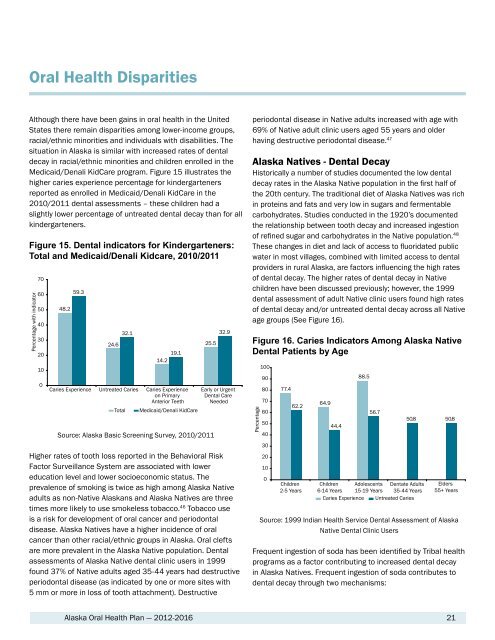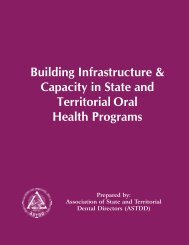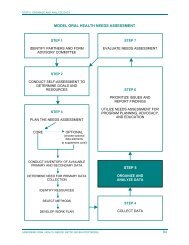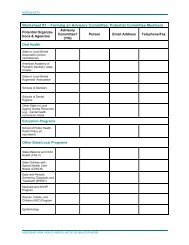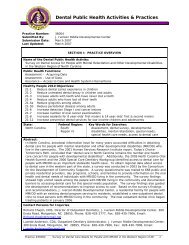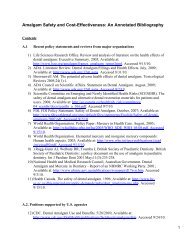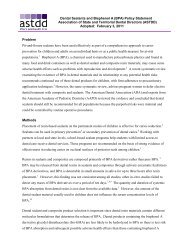AlAskA OrAl HeAltH PlAn - Alaska Department of Health and Social ...
AlAskA OrAl HeAltH PlAn - Alaska Department of Health and Social ...
AlAskA OrAl HeAltH PlAn - Alaska Department of Health and Social ...
You also want an ePaper? Increase the reach of your titles
YUMPU automatically turns print PDFs into web optimized ePapers that Google loves.
Oral <strong>Health</strong> Disparities<br />
Although there have been gains in oral health in the United<br />
States there remain disparities among lower-income groups,<br />
racial/ethnic minorities <strong>and</strong> individuals with disabilities. The<br />
situation in <strong>Alaska</strong> is similar with increased rates <strong>of</strong> dental<br />
decay in racial/ethnic minorities <strong>and</strong> children enrolled in the<br />
Medicaid/Denali KidCare program. Figure 15 illustrates the<br />
higher caries experience percentage for kindergarteners<br />
reported as enrolled in Medicaid/Denali KidCare in the<br />
2010/2011 dental assessments – these children had a<br />
slightly lower percentage <strong>of</strong> untreated dental decay than for all<br />
kindergarteners.<br />
Figure 15. Dental indicators for Kindergarteners:<br />
Total <strong>and</strong> Medicaid/Denali Kidcare, 2010/2011<br />
Percentage with indicator<br />
70<br />
60<br />
50<br />
40<br />
30<br />
20<br />
10<br />
0<br />
48.2<br />
59.3<br />
24.6<br />
32.1<br />
19.1<br />
14.2<br />
Caries Experience Untreated Caries Caries Experience<br />
on Primary<br />
Anterior Teeth<br />
Total<br />
Medicaid/Denali KidCare<br />
25.5<br />
Source: <strong>Alaska</strong> Basic Screening Survey, 2010/2011<br />
32.9<br />
Early or Urgent<br />
Dental Care<br />
Needed<br />
Higher rates <strong>of</strong> tooth loss reported in the Behavioral Risk<br />
Factor Surveillance System are associated with lower<br />
education level <strong>and</strong> lower socioeconomic status. The<br />
prevalence <strong>of</strong> smoking is twice as high among <strong>Alaska</strong> Native<br />
adults as non-Native <strong>Alaska</strong>ns <strong>and</strong> <strong>Alaska</strong> Natives are three<br />
times more likely to use smokeless tobacco. 46 Tobacco use<br />
is a risk for development <strong>of</strong> oral cancer <strong>and</strong> periodontal<br />
disease. <strong>Alaska</strong> Natives have a higher incidence <strong>of</strong> oral<br />
cancer than other racial/ethnic groups in <strong>Alaska</strong>. Oral clefts<br />
are more prevalent in the <strong>Alaska</strong> Native population. Dental<br />
assessments <strong>of</strong> <strong>Alaska</strong> Native dental clinic users in 1999<br />
found 37% <strong>of</strong> Native adults aged 35-44 years had destructive<br />
periodontal disease (as indicated by one or more sites with<br />
5 mm or more in loss <strong>of</strong> tooth attachment). Destructive<br />
periodontal disease in Native adults increased with age with<br />
69% <strong>of</strong> Native adult clinic users aged 55 years <strong>and</strong> older<br />
having destructive periodontal disease. 47<br />
<strong>Alaska</strong> Natives - Dental Decay<br />
Historically a number <strong>of</strong> studies documented the low dental<br />
decay rates in the <strong>Alaska</strong> Native population in the first half <strong>of</strong><br />
the 20th century. The traditional diet <strong>of</strong> <strong>Alaska</strong> Natives was rich<br />
in proteins <strong>and</strong> fats <strong>and</strong> very low in sugars <strong>and</strong> fermentable<br />
carbohydrates. Studies conducted in the 1920’s documented<br />
the relationship between tooth decay <strong>and</strong> increased ingestion<br />
<strong>of</strong> refined sugar <strong>and</strong> carbohydrates in the Native population. 48<br />
These changes in diet <strong>and</strong> lack <strong>of</strong> access to fluoridated public<br />
water in most villages, combined with limited access to dental<br />
providers in rural <strong>Alaska</strong>, are factors influencing the high rates<br />
<strong>of</strong> dental decay. The higher rates <strong>of</strong> dental decay in Native<br />
children have been discussed previously; however, the 1999<br />
dental assessment <strong>of</strong> adult Native clinic users found high rates<br />
<strong>of</strong> dental decay <strong>and</strong>/or untreated dental decay across all Native<br />
age groups (See Figure 16).<br />
Figure 16. Caries Indicators Among <strong>Alaska</strong> Native<br />
Dental Patients by Age<br />
Percentage<br />
100<br />
90<br />
80<br />
70<br />
60<br />
50<br />
40<br />
30<br />
20<br />
10<br />
0<br />
77.4<br />
62.2<br />
Children<br />
2-5 Years<br />
64.9<br />
44.4<br />
88.5<br />
56.7<br />
50.8<br />
Children<br />
6-14 Years<br />
Adolescents<br />
15-19 Years<br />
Dentate Adults<br />
35-44 Years<br />
Caries Experience Untreated Caries<br />
50.8<br />
Elders<br />
55+ Years<br />
Source: 1999 Indian <strong>Health</strong> Service Dental Assessment <strong>of</strong> <strong>Alaska</strong><br />
Native Dental Clinic Users<br />
Frequent ingestion <strong>of</strong> soda has been identified by Tribal health<br />
programs as a factor contributing to increased dental decay<br />
in <strong>Alaska</strong> Natives. Frequent ingestion <strong>of</strong> soda contributes to<br />
dental decay through two mechanisms:<br />
<strong>Alaska</strong> Oral <strong>Health</strong> Plan — 2012-2016<br />
21


